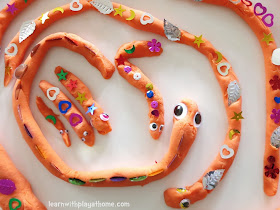Welcome back to the "Playful Maths" series brought to you by
Together, let's make MATHS FUN!
............................................................................................................
Last week I shared a Playdough Flower Mat.
This weeks Playful Maths Activities also uses the sensory material Play dough (playdoh).
In this activity we are focusing on length, measurement and patterns.
Other skills involved include fine motor, comparing and ordering.
Ages: 2+ (Maddie is currently 4)
(See the Handy Tips at the bottom to simplify or extend to meet your child's needs)
"Let's make snakes" was the only thing I said before Maddie was off and rolling!
Materials: Playdough, assorted googly eyes (optional*), assorted sequins (optional*)
(*you can use your own alternatives for these. ie you could poke the eyes in, use pebbles for eyes, decorate with buttons, natural materials..etc.etc)
"Let's make snakes" was the only thing I said before Maddie was off and rolling!
She leapt into this activity so quickly that there was barely time to snap what she was doing.
She loved choosing from the range of different sized eyes.
(She decided upon "medium" sized eyes for her "medium" sized snake)
As soon as one snake was made it was onto the next. This time a "baby snake"
The baby snake was very tiny and much smaller compared to the first snake.
I challenged her: "Can you make another snake the same length as the first snake?"
Comparing the lengths she discovered her snake was shorter than the first snake.
She knew it had to be longer so she added extra playdough
But then it was too long so she promptly chopped the tail to make them the same length.
"I'm making a GIGANTIC snake now"
It wasn't easy to roll out something so long without breaking it.
It was also a challenge to keep the thickness the same.
She decided this one would be the same length as the table.
And of course it got the biggest eyes.
We compared the length of the giant snake to the other snakes she'd made and were thrilled to discover that it was the same length as 2 medium snakes and 2 small snakes.
We then ordered the snakes from smallest to largest or shortest to longest.
Maddie made a few more snakes and slotted them in between the other snakes according to it's length.
She decided she'd made enough snakes and then moved them into a pattern on the table.
She was incredibly keen to decorate the snakes. I didn't specifically request patterning but we were able to practice some of that too. We used a variety of different coloured, shaped sequins which we reuse a lot of the time.
She started decorating the "baby snakes" while I started a repetitive pattern on the "grandma snake"
There was a lot of dialogue that went on during our play. Explanations of why each snake was patterned in a certain way, their names, where they fit in the "snake family" and so on.
Sequins are especially good for practicing pincer grip (as are the googly eyes!) and working those fine-motor skills. They can be tricky though.
She discovered my pattern and wanted to complete it.
She then did her own repetitive pattern using 4 different elements that I was really impressed with.
(It's the silver leaf, silver heart, gold moon, gold star pattern on the snake with the yellow eyes. Not bad for a 4 year old) :)
Our snake family. Yes, this was maths. We had a ball!
Handy Tips
- Simplify this activity by assisting your child to roll out a couple of snakes and talk about one being longer than the other. Try adding another snake in to make one large, medium and small snake.
- Extend this activity by:
- Using informal units to measure the snakes (ie. the biggest snake is 10 hands long)
- Using formal measurement to find the lengths (ie. a tape measure)
- Using the snakes to measure things around the house/classroom (the sofa is 3 snakes long)
- Writing about the different snakes and their lengths
- Making up a narrative and then performing it with the snakes as characters
- Mix it up with different coloured playdough and other decorative materials such as beads, buttons, pebbles etc.
- Change the activity by making snakes from stockings filled with scrunched paper to use for measurement. You could make it exactly 1 metre long and take it around for measuring fun.
- Use the mathematical language that goes naturally with this activity, such as, "length," "measure," "big," "small," "long," short," "medium," "pattern," etc
- We used our no-cook playdough recipe to make the playdough used in this activity.
- We used our no-cook playdough recipe to make the playdough used in this activity.
- Did you see our Playful Maths with Natural Materials? Turns out they were very popular so if you haven't seen them, click the pictures below to check them out.
You can see the rest of our Playful Maths here. So far we've covered a range of easily accessible materials, many of which were recycled or came from nature.
Don't forget to join us next week where we're bringing you more Playful Maths activities.
Happy playing,
Debs :)
Follow the entire series on our
Look where else we are. Are you following along? :)
New Here? Subscribe to get all activities sent directly to you


























